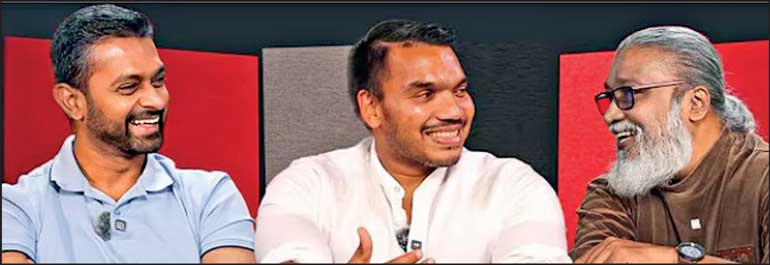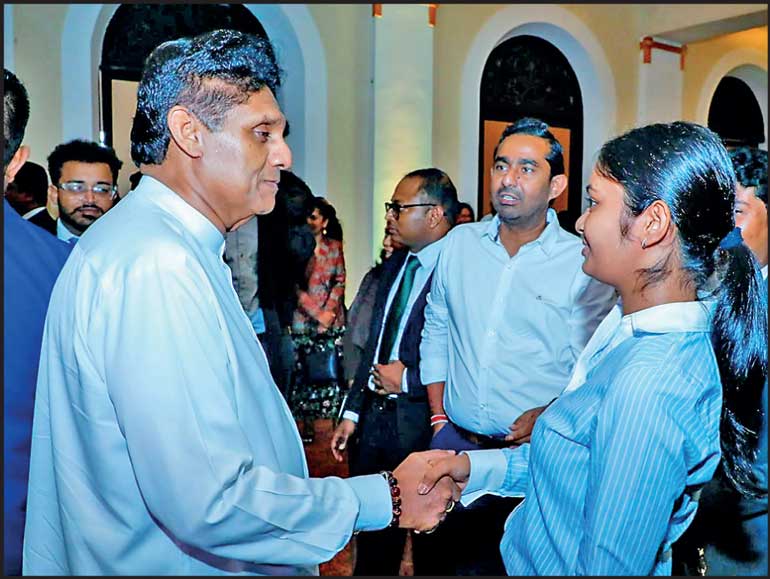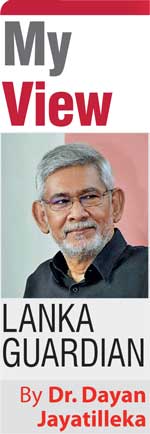Wednesday Jan 07, 2026
Wednesday Jan 07, 2026
Thursday, 14 August 2025 00:40 - - {{hitsCtrl.values.hits}}

Namal Rajapaksa’s major interview

No generation gap

MR: Unique brand and heritage

GR: More liability than asset

Locating Lakshman Kadirgamar, 20 years later
“…But, if our government changes in the next five years while we are in the process of making this change, then everything we started would be ruined. The next group would do something different. That is why we think that if a government can stay in power for 15, 20 or 25 years. Only then would it be able to take the country forward under one vision, one policy framework.”
– Tilvin Silva, General Secretary, JVP
 Lakshman Kadirgamar as archetype
Lakshman Kadirgamar as archetype
Lakshman Kadirgamar was assassinated by a Tiger sniper 20 years ago this week. He epitomised an enlightened way of being Sri Lankan, and positioning and representing Sri Lanka in the world.
To borrow terminology that emerged during JFK’s presidency and the Cuban Missile Crisis, one way of being is as a dove. A Sri Lankan dove was for federalism and endless, repeated appeasement of Prabhakaran in the absurd hope of peace, despite the evidence to the contrary.
The other way of being Sri Lankan is as a hawk. A hawk was for war with the LTTE and against devolution/autonomy, i.e. power-sharing with the Tamils.
The third way of being Sri Lankan is as an owl. An owl was for devolution to resolve the political problem with the Tamils, combined with steely military resolve against secession, and vigilant defense of Sri Lanka’s sovereignty, territorial integrity and unity. Lakshman Kadirgamar was an owl.
As for Sri Lanka’s ways of being in the world, Ranil Wickremesinghe and Mangala Samaraweera represented one way, that of servile capitulationism exemplified in the co-sponsored Geneva Resolution of 2015. (Even in retirement, the dissentient Ambassador at the time hasn’t told the story of this dangerous betrayal).
Gotabaya Rajapaksa (and earlier, Sajin Vass Gunawardena) represented another way: mulish claims of ‘zero civilian casualties’, cultural exceptionalism and civilisational superiority, incurring serial defeats in the UNHRC, losing many friends in the Global South and squandering our May 2009 diplomatic victory in Geneva.
Kadirgamar’s firm opposition to the PTOMS sellout to Prabhakaran (frozen by the Supreme Court, shunned by the USA), negotiated and advocated by a leading light in Sri Lankan diplomacy, revealed antinomian archetypes, schools of thought and diplomatic traditions.
Lakshman Kadirgamar represented the third way of being in the world: active, robust, multidirectional international engagement; outspoken articulation, upholding national sovereignty and solidarity of the global South. Hamilton Shirley Amerasinghe, Gamani Corea and Neville Kanakaratne, exemplars of this Great Tradition, were his forerunners.
Dictatorship and Opposition politics
If there is any unfamiliarity in understanding the fundamental dynamics of competitive multiparty democracy and the change of governments, any revulsion against citizens being able to choose a certain policy package and then make a change or course correction 4-5 years later, it sure doesn’t come from the Opposition. The autocratic vision comes from the powerful General-Secretary of the ruling JVP. Tilvin Silva is a hard man. The JVP is a determined, dedicated, disciplined party. The Opposition must take his statement and its implications very seriously.
World political history, extending from the victorious alliance against Nazism (Churchill-Stalin-Roosevelt-De Gaulle), to the defeat of the dictator Pinochet in Chile, proves that the surest antidote to dictatorship is a broad united front which transcends ideological barriers.
Who should the Opposition rally round? There can be a joint leadership or small coordinating body, but it cannot be an unwieldy collection of “all Chiefs, no Injuns”. A united front must be led by one or more national figures with mass bases, not sects or cults. It certainly cannot have as a leader, Ranil Wickremesinghe, the very epitome of sustained electoral failure even after his stint as President selected by parliament (not popular vote) who stabilised the economy as the IMF’s local overseer. In 2024 he lost to Sajith Premadasa and ensured the victory of Anura Dissanayake.
Having been aware of international and national politics for just over six decades, I can see only two viable leaders in Sri Lanka’s Opposition politics. The Opposition space is bipolar, not multipolar. Either these two have to be brought together, or the gaps bridged by some coordinating body, or the voters will have to allocate them places in a national division of labour through an election.
Namal’s watershed interview
I’d like to share a recent experience which I found politically illuminating and uplifting. It is an episode of a new YouTube show co-hosted by two contrasting personalities, veteran social media presenter and former promoter of AKD and the NPP, Sepala Amarasinghe (who urged in 2024 that a future NPP administration shouldn’t tap me as an Ambassador), and one of the SJB’s smart young rising stars, Charith Abeysinghe. The program is called ‘Vipakshaya Hadana Thana’ i.e., ‘The Place Where The Opposition is Being Made/Built’.
I was unaware of the show, but a distinguished retired public servant of senior rank sent it to me. The episode was a searching, challenging conversation with Namal Rajapaksa which lasted a little over an hour—doubtless a slight overrun due to the dynamism of the discussion. My wife Sanja and I watched it all the way through at a single sitting. The co-hosts did their job so well that they nudged Namal out of his public persona to the next level, making him reveal more of his views and attitudes, his perspective, than on any public forum before. The program and what he said made me feel more optimistic about this country. (https://www.youtube.com/watch?v=S76JO5txMC4)
Firstly, the show itself proved the possibility of a civilised, cross-party public conversation. Secondly, it proved the ground existed for a cross-party consensus in the Opposition. Thirdly, the give-and-take on the show indicated that a pragmatic, rational, moderately progressive centre could be created across party lines, in contradistinction to the smug, unipolar unilateralism of the Anura administration and the ultranationalism and right-wing ideology on the Opposition’s fringe. Fourthly, the show gave me more insight into Namal’s national potentialities as a leader than I had before.
Namal is an excellent public communicator, expressive, responsive, good-humoured, personable. He’d make a great presidential candidate.
In substantive terms he comes across as an unusual, interesting combination of a pragmatic developmentalist, knowledgeable about how things work and do not work; someone who will strive to modernise his country as rapidly and constructively as possible; very open to the outside world, while also being very aware of the dangers of demoralising, weakening and dismantling the Sri Lankan state as this Government is doing.
He shares with the UNP, SJB, SLFP and some may mistakenly argue, AKD’s NPP, a developmentalist-modernising drive. But he differs in two respects:
 He has a far readier familiarity and fluency with detail, and practical knowledge of big projects as growth-engines, than the UNP, SJB and NPP.
He has a far readier familiarity and fluency with detail, and practical knowledge of big projects as growth-engines, than the UNP, SJB and NPP.
 While he is not a ‘statist’ like his father, he has a significantly greater pragmatic awareness than the SJB, UNP and NPP of the importance of the state and the imperative to defend it from nihilistic attacks.
While he is not a ‘statist’ like his father, he has a significantly greater pragmatic awareness than the SJB, UNP and NPP of the importance of the state and the imperative to defend it from nihilistic attacks.
The SJB’s Charith Abeysinghe who handled himself, his co-host Sepala Amarasinghe, and Namal excellently throughout the show, pointedly concluded with a question to young Rajapaksa about how he views a coalition government-- implicitly meaning among Opposition forces. Keeping his options open, Namal dodged it. But that the question was posed by Charith tells me there’s an undercurrent that could create such a formation when the moment ripens.
Only viable options: Sajith, Namal
Sri Lanka’s economic success was conspicuous during three periods in my lifetime, but only two of those three were sustainable, with the first having created grave socioeconomic and therefore systemic disequilibrium.
The first was the opening of the economy in 1977, which was a real democratisation in that people could earn a wage, walk into a store and buy foodstuffs like Marmite and milk-foods which for seven years had been unavailable luxuries except for those of us from privileged social layers. I still regard the 1977 Open Economy as more progressive than not-- that’s why I don’t comfortably belong in the SLFP tradition. But then again, I regard SWRD’s 1956 victory as more progressive than not—that’s why I don’t fit comfortably in the UNP tradition.
The socioeconomic downside of the 1977 Open Economy was so great that Prime Minister Ranasinghe Premadasa, who had consistently warned about it from 1978, had to appoint the Warnasena Rasaputram Commission on Poverty. That Commission was the prelude to the Janasaviya program. Thus, the 1977 Open Economy as it was, is not an acceptable, replicable development paradigm. Going further down that road as Ranil tried and Harsha de Silva urges, is politico-electorally suicidal.
As Namal Rajapaksa takes pains to point out in his YouTube interview, neither he nor Sajith Premadasa are their respective fathers and therefore should not be compared and contrasted with them. Having worked with both presidents Ranasinghe Premadasa and Mahinda Rajapaksa, I would agree that the sons are pragmatists while their fathers were heroic risk-takers and ‘romantic realists’. However, both Sajith and Namal are aware of their fathers’ development successes and the logic behind them. Something has rubbed off.
Sajith’s speech in response to President Anura Dissanayake’s most recent address to Parliament, was as usual a master class on macroeconomics, far superior to AKD and anyone else on either side in Parliament. (https://youtu.be/OfZy-QDoURU?si=I2vtTyZoUF9D0TfM)
Whichever option we choose in 2029, Sajith or Namal, Sri Lanka will come out from the tunnel we’re now in and have been in since Ranil borrowed heavily from the private foreign money markets in 2019-- and we’ll start making up for lost ground. But for this country to regain its potential, a victory for Namal or Sajith in and of itself will not do —not only because, by their own insistence, neither one of them is their father, but also because neither the SJB nor SLPP are sufficiently strong, evolved formations. Therefore, while Sri Lanka can do much better if either Sajith or Namal is elected President than it did under Ranil, Gota, and Anura—that post-MR 2015 troika comprise a low bar—it will take an equation of Sajith and Namal (in whichever order), and the SJB and SLPP, for Sri Lanka to fulfil its economic-developmental potential.
Who will lead?
Given the strengths Sajith and Namal can contribute to the project of national revival and re-launch, I tend to disregard stories of new combinations of Opposition personalities, not because I regard them as untrue, but because if neither Sajith nor Namal lead, these will remain collections of sundry Opposition elements, not Opposition forces. The ego-centric aspirants just don’t have the politico-electoral real estate, and constitute a fringe. Moreover, many of these elements have far more negative histories (e.g. racism, Islamophobia) than Sajith or Namal.
At a national election, no voter will waste his/her vote on a third candidate. Having experimented with the President from Galewela, Matale, educated formatively in Tambuttegama, the voter will probably find the historic Rajapaksa and Premadasa brands that Namal and Sajith have the franchise for, to be a safer bet.
There is no Opposition formation which isn’t led by either Sajith or Namal, which should be taken seriously. I just do not see anyone other than Sajith and Namal, and the SJB and SLPP (in whichever order) developing the necessary mass base to electorally defeat the incumbent administration. Any rational player in the Opposition has two realistic options: line up with either Sajith or Namal, or act as a bridge bringing the two, and their respective parties, together.
Initially, there could be two Opposition formations, led by Sajith and Namal respectively, which could, should, combine before a national election. If they don’t, the voters will make the choice.
The best post-AKD/post-NPP scenario is one that has both Sajith and Namal in co-government or political co-habitation. If we aren’t lucky enough to have them enter an equation, the voters can – and will-- decide who should be AKD’s successor and which party should lead the legislature, i.e., who should be President and PM respectively.
I don’t regard the question as to whether Sajith/SJB or Namal/SLPP should be the choice, as a zero-sum game. When it was debated in China whether the rural peasantry or the urban proletariat was/should be the main player in the Revolution, Maoism provided a unifying formula, but distinguishing between the main force and the leading force: the peasantry was the main force, the proletariat the leading force.
We need both Sajith and Namal, one as the main force, the other as the leading force. The situation will show who will play which role, or the voters will decide who should be allocated which.
Economics is our greatest challenge at the moment, and Sajith clearly has the soundest grasp of macroeconomics. But things might change. The arrest of a former commander of one of the three armed forces is indicative of a creeping threat to the Sri Lankan state. Electoral history in Sri Lanka and worldwide shows that economics hardly ever appears in a pure form. It is either mixed-in with other issues of a more emotive, explicitly political sort, or manifests itself in a hybrid or ‘fused’ form.
To the extent that issues of a national or patriotic character which cause apprehensions about sovereignty and the safety of the state come to the fore, then Sajith and SJB are at a disadvantage because unlike Ranasinghe Premadasa, he and his party fight shy of championing national-patriotic causes. In such a context, Namal Rajapaksa and the SLPP will have an advantage. Namal’s spirited temperament is more suited to face such challenges while Sajith’s sedate style is better suited to managing a straightforward economic-developmental challenge.
There is another variable. So long as the SJB seems to represent continuity with Ranil Wickremesinghe’s UNP and its economic policies, Sajith will be at a disadvantage. But with poverty growing unprecedentedly rapidly, the greater Sajith’s identification is with the twin signature policies of his father, Ranasinghe Premadasa—poverty alleviation and rapid export-led rural industrialisation—the more he will enjoy a credible comparative advantage.
To the extent that Namal’s starting point – but not endpoint--is the achievement and inspiration of Mahinda Rajapaksa, he will have an advantage, but if there are unexorcised ghosts of Gotabaya rule (anti-farmer policies, anti-minority profile, Islamophobic practices, international isolation) haunting the SLPP, it will be to Namal’s disadvantage. MR is an asset, GR a liability.
Return to Centre
The AKD-led JVP-NPP Government has been such a step backward in our post-Independence history of economic and human development, that a return from the Fake Left to the mainstream democratic Centre, would be a step forward. Actually.
Sri Lanka needs to retrace its steps to the point before the economic downslide began with the defeat of Mahinda Rajapaksa in 2015, the Yahapalanaya UNP’s halt of Chinese projects and Ranil’s heavy resort to private foreign debt.
The country has to return to zone of the ‘developmentalist’ progressive centre (Premadasa/Mahinda) as a detour and transition—before it moves forward someday to a different, pluralist-democratic left, quintessentially Social Democratic, in a multi-party Broad Front as in Latin America.
(https://dayanjayatilleka.webflow.io/)